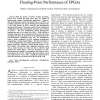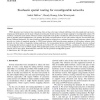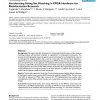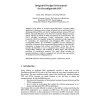110
Voted
TVLSI
2008
15 years 16 days ago
2008
With the density of FPGAs steadily increasing, FPGAs have reached the point where they are capable of implementing complex floating-point applications. However, their general-purpo...
122
click to vote
PPL
2008
15 years 18 days ago
2008
This paper presents the FPGA implementation of the prototype for the Data-Driven Chip-Multiprocessor (D2-CMP). In particular, we study the implementation of a Thread Synchronizati...
104
Voted
MAM
2006
15 years 18 days ago
2006
FPGA placement and routing is time consuming, often serving as the major obstacle inhibiting a fast edit-compile-test loop in prototyping and development and the major obstacle pr...
110
Voted
MAM
2008
15 years 18 days ago
2008
This paper presents a design methodology for a hybrid Hardwarein-the-Loop (HIL) tester tool, based on both discrete event system theory, given by timed automata, and continuous sy...
110
click to vote
IJES
2006
15 years 19 days ago
2006
This paper describes novel methods of exploiting the partial, dynamic reconfiguration capabilities of Xilinx Virtex V1000 FPGAs to manage single-event upset (SEU) faults due to rad...
160
Voted
FTEDA
2006
15 years 19 days ago
2006
Design automation or computer-aided design (CAD) for field programmable gate arrays (FPGAs) has played a critical role in the rapid advancement and adoption of FPGA technology ove...
135
Voted
BMCBI
2008
15 years 23 days ago
2008
Background: This paper describes techniques for accelerating the performance of the string set matching problem with particular emphasis on applications in computational proteomic...
144
click to vote
FPGA
2010
ACM
15 years 25 days ago
2010
ACM
We use reconfigurable hardware to construct a high throughput Bayesian computing machine (BCM) capable of evaluating probabilistic networks with arbitrary DAG (directed acyclic gr...
110
click to vote
ARC
2010
Springer
15 years 25 days ago
2010
Springer
Using FPGAs to accelerate High Performance Computing (HPC) applications is attractive, but has a huge associated cost: the time spent, not for developing efficient FPGA code but fo...
139
Voted
ISLPED
2010
ACM
15 years 25 days ago
2010
ACM
Memories play a key role in FGPAs in the forms of both programming bits and embedded memory blocks. FPGAs using non-volatile memories have been the focus of attention with zero bo...




